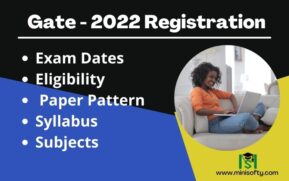
The syllabus is very important for cracking any competitive exam. Without knowing the syllabus, we can not prepare well for any exam. If we want to prepare for any exam, first we need to briefly examine a particular subject’s syllabus and paper pattern.
Learn more about Gate Exam 2025.
Table of Contents
The latest Gate CSE and IT (Revised) syllabus is Newly updated.
Section 1: GA (General Aptitude)
Verbal Aptitude
Basic English grammar: tenses, articles, adjectives, prepositions, conjunctions, verb-noun agreement, and other parts of speech
Basic vocabulary: words, idioms, and phrases in context Reading and comprehension Narrative sequencing.
Quantitative Aptitude
Data interpretation: data graphs (bar graphs, pie charts, and other graphs representing data), 2- and 3-dimensional
plots, maps, and tables.
Numerical computation and estimation: ratios, percentages, powers, exponents and logarithms, permutations and
combinations, and series Mensuration and Geometry
Elementary statistics and probability.
Analytical Aptitude
Logic: deduction and induction Analogy, Numerical relations and reasoning
Spatial Aptitude
Transformation of shapes: translation, rotation, scaling, mirroring, assembling, and grouping
Paper folding, cutting, and patterns in 2 and 3 dimensions.
Section 2: Engineering Mathematics.
According to the Gate Computer Science Council, the engineering mathematics section is the same as all engineering branches but follows the mathematics syllabus for mainly computer science branch students.
Discrete Mathematics: Propositional and First-Order Logic. Sets, relations, functions, partial orders, and lattices. Groups. Graphs: connectivity, matching, coloring. Combinatorics: counting, recurrence relations, generating functions.
Linear Algebra: Matrices, determinants, the system of linear equations, eigenvalues and eigenvectors, LU decomposition.
Calculus: Limits, continuity, and differentiability. Maxima and minima. Mean value theorem. Integration.
Probability and Statics: Random Variables. Uniform, normal, exponential, Poisson, and binomial distributions. Mean, median, mode, and standard deviation. Conditional probability and Bayes theorem.
Section 3: Computer Science and Information Technology (Core Subjects)
Theory of Computation
Regular expressions and finite automata. Context-free grammars and push-down automata.
Regular and context-free languages, pumping lemma. Turing machines and undecidability.
Digital Logic
Boolean algebra. Combinational and sequential circuits. Minimization. Number representations
and computer arithmetic (fixed and floating-point).
Computer Organization and Architecture
Machine instructions and addressing modes. ALU, data‐path, and control unit. Instruction
pipelining, pipeline hazards. Memory hierarchy: cache, main memory, and secondary storage;
I/O interface (interrupt and DMA mode).
Programming and Data Structures
Programming in C. Recursion. Arrays, stacks, queues, linked lists, trees, binary search trees,
binary heaps, graphs.
Algorithms
Searching, sorting, hashing. Asymptotic worst-case time and space complexity. Algorithm
design techniques: greedy, dynamic programming, and divide‐and‐conquer. Graph traversals,
minimum spanning trees, shortest paths
Compiler Design
Lexical analysis, parsing, syntax-directed translation. Runtime environments. Intermediate code
generation. Local optimisation, Data flow analyses: constant propagation, liveness analysis,
common subexpression elimination.
Operating System
System calls, processes, threads, inter‐process communication, concurrency, and
synchronization. Deadlock. CPU and I/O scheduling. Memory management and virtual memory.
File systems.
Databases
ER‐model.
Relational model: relational algebra, tuple calculus, SQL. Integrity constraints,
normal forms. File organization, indexing (e.g., B and B+ trees). Transactions and concurrency
control.
Computer Networks
Concept of layering: OSI and TCP/IP Protocol Stacks; Basics of the packet, circuit, and virtual circuit-
switching;
Datalink layer: framing, error detection, Medium Access Control, Ethernet bridging;
Routing protocols: shortest path, flooding, distance vector, and link-state routing; Fragmentation
and IP addressing, IPv4, CIDR notation, Basics of IP support protocols (ARP, DHCP, ICMP),
Network Address Translation (NAT);
Transport layer: flow control and congestion control, UDP,
TCP, sockets; Application layer protocols: DNS, SMTP, HTTP, FTP, Email.
Click here to download Gate 2022 computer science and IT Syllabus free Pdf.



2 Comments